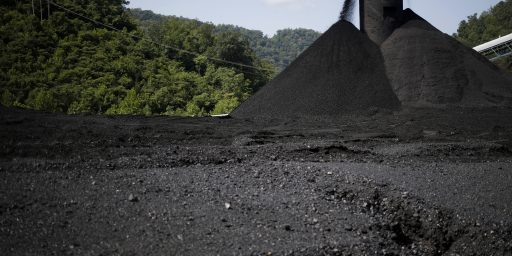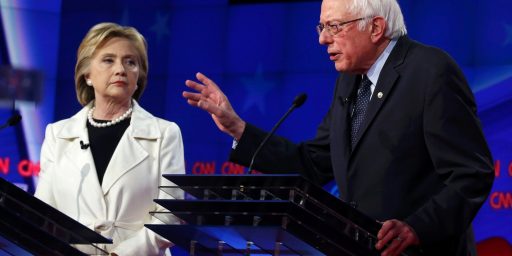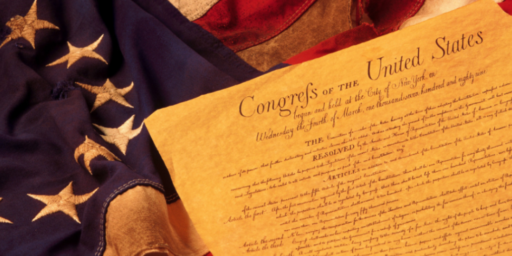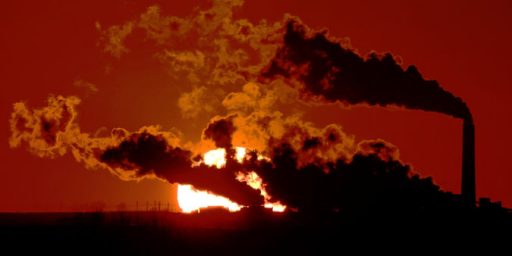Bush Administration’s Mine Safety Record
Since the tragic death of twelve men in the Sago mine Tuesday night, there have been charges that the Bush administration is partly to blame because they changed mine safety rules to benefit big business at the expense of miners. It turns out not to be that simple.
Seth Borenstein, Linda J. Johnson and Lee Mueller have an in-depth story for Knight-Ridder that, because of its arrangement and the headlines chosen by their affiliates, gives the former impression but, if one keeps reading, tells the truth.
Some representative headlines from GoogleNews:
Mine fines smaller with Bush (Billings Gazette)
Enforcement of mine safety seen slipping under Bush (San Jose Mercury News)
Enforcement of mine safety seen slipping under Bush (Belleville News Democrat)
Mine-safety measures less likely to be enforced (Contra Costa Times)
Bush White House easy on mine safety violators (Salt Lake Tribune)
Mine safety violations met with leniency (Springfield News Leader)
Mining companies get off cheap despite violations (Duluth News Tribune)
The story:
Since the Bush administration took office in 2001, it has been more lenient toward mining companies facing serious safety violations, issuing fewer and smaller major fines and collecting less than half of the money that violators owed, a Knight Ridder investigation has found. At one point last year, the Mine Safety and Health Administration fined a coal company a scant $440 for a “significant and substantial” violation that ended in the death of a Kentucky man. The firm, International Coal Group Inc., is the same company that owns the Sago mine in West Virginia, where 12 workers died earlier this week. The $440 fine remains unpaid.
Relaxed mine safety enforcement is widespread, according to a Knight Ridder analysis of federal records and interviews with former and current federal safety officials, even though deaths and injuries from mining accidents have hovered near record low levels in the past few years.
The analysis shows:
- The number of major fines over $10,000 has dropped by nearly 10 percent since 2001. The dollar amount of those penalties, when adjusted for inflation, has plummeted 43 percent to a median of $27,584.
- Less than half of the fines levied between 2001 and 2003 – about $3 million – have been paid.
- The budget and staff for the enforcement office also have declined, forcing the agency to make do with about 100 fewer coal mine enforcement personnel.
- In serious criminal cases, the number of guilty pleas and convictions fell 54.8 percent since 2001. In the first four years of the Bush administration, the federal government has averaged 3.5 criminal convictions a year; in the four years before that the average was 7.75 per year.
Officials at the Mine Safety and Health Administration and the Department of Labor didn’t respond by Friday evening to a list of 13 e-mail questions or to a request for an interview. Davitt McAteer, who headed the mine safety agency during the Clinton administration, said it has become a “paper tiger.” “The numbers indicate that they haven’t had as much in the area of enforcement,” said McAteer, now a vice president at Wheeling Jesuit University. “It suggests that the whole system is kind of bogging down.” McAteer said that without the stick of high fines, mandated payments of those penalties and consistent follow-up inspections, there’s little incentive for companies to repair safety problems.
Why, it’s almost as if George W. Bush killed those miners himself!
There’s more:
- The mine safety agency touts on its Web site statistics showing the agency’s “overall record of increased enforcement against mine operators during this Administration.” Those statistics show that in 2005, the agency issued 4 percent more violation notices for all mines than it did in 2000 and that the number of coal mine violations issued increased by 18 percent. The agency also touted a 13 percent increase in “significant and substantial” violations. But those numbers hide the fact that most of those fines are so small that they’re meaningless to big coal and mining companies, said Dennis O’Dell, a health and safety administrator for the United Mine Workers of America union.
So, Bush not only kills miners but he puts up deceitful numbers on government web sites. For shame!
But 22 paragraphs* into the story, we get this bit of information:
David Gooch, president of Coal Operators and Associates in Pikeville, Ky., which has 200 members, said the size of the fines have nothing to do with who’s in power in Washington. “It doesn’t have anything to do with who’s the president because, actually, the people who are doing those fines are apolitical,” Gooch said. “They’re employees that are covered by the federal civil service, and their own union, by the way, so they compute the fines the way they come out.”
But Bush and Cheney (and probably Rumsfeld, too) are probably pushing them to hand out low fines, since they hate miners and all, right?
Read down to paragraph 25*:
Mining industry officials defended the Bush administration and pointed to recent years of record low deaths and injuries in mining as the most important numbers. For coal mining, 2005 and 2002 were record low years for fatalities. Only 22 people were killed last year in coal mining deaths – down from 47 in 1995. The number of workers killed in all mines hit consecutive record lows of 56 and 55 in 2003 and 2004, respectively, but increased slightly to 57 in 2005. “Within the last five years the number of fatalities have been cut in half,” said National Mining Association spokeswoman Carol Raulston. “From our perspective that’s where we ought to be focused. It is what is happening to the absolute number of injuries – and the rate of injuries – that has gone down. Mining is no longer the most dangerous industry in the United States.”
Regardless of who does the inspections, former agency officials say the marching orders on enforcement changed with the Bush administration. “Right off the bat, when they came in they said we want to focus more on partnerships, alliances, working together with industry,” said Celeste Montforton, who was special assistant to the MSHA chief for six years through December 2001. “They did feel there was too much of a focus on enforcement.”
So, rather than handing out fines after the fact, they changed the focus to solving problems ahead of time and trying to come up with regulations that took into account actual conditions in the mining industry? And, coincidentally, they have had record low fatalities year after year?
Why is that buried in the part of the article that most newspapers are likely to cut out to make the story fit?
Now, it’s possible that the lower number of deaths during the Bush administration is a statistical anomaly. Maybe their are fewer miners than there were before. Maybe they have just been lucky and there have been few deaths despite shoddy enforcement. But to hype the idea that the Administration has cut enforcement for mining safety in the wake of a mining disaster and then bury all information pointing the other way is irresponsible.
See Jason Smith for more on this story.
*Note: My count is based on the Billings Gazette edition. As is often the case, my excerpts combine paragraphs to conform with the conventions of English grammar rather than journalistic writing.






The paragraph about the mine agency refusing comment on a Friday afternoon seems to imply that the reporter “ambushed” the agency with a story on a Friday, when a lot of folks are winding down for the week. Did they e-mail the questions on Monday and wait until Friday? That’s not clear. If they e-mailed on Friday, expecting a reply by Friday, that’s a little unfair, even by journalistic standards.
enforcement should be high [even jail time] but the fines moderate. force them to spend the”fine money” on the needed improvements. that way the problems are fixed without unnecessary price increases and wage cuts.also they should concentrate on serious safety violations and differentiate between them and the petty stuff.the bureaucrats that are sent to inspect are often inexperienced or incompetent and pushy. ready to “choke on a horsefly but swallow a horse”. better results are achieved through cooperative rather than adversarial approaches like OSHA’s VPP volunary protection program. it works. check out the VPPPA [participants assoc.] for more information. NOTE TO BUSH HATERS..legitimate complaints have more credibility and wider appeal.
Looks like your trackback is still trashed, James.
Here’s what I’ve tried to track back :
Why, the answer is simple, James. It’s called “the template” the rules of the template are simple if it makes the president look bad it runs on page one, above the fold. it makes the president look good or Democrats look bad, it runs on A-23 below the fold.
So, the Bush administration is definitely not guilty of a conspiracy to reduce punishment for mine owners and operators…but the media is definitely guilty of a conspiracy to make the Democrats look good Bush administration look bad.
Do you think that there might be a bias present in this sort of thinking?
This is the very reason that I say Democrats and leftys are born to lie. I knew it was just a metter of time before some lefty liberal would somehow blame Bush
Doesn’t it make you sick.
jim; do you think that bitheads comment is not true? it sounds to me like you have no knowledge of what dangerous occupations were like before OSHA,nor are you aware of what they are like today. even so,i do hope you never get a papercut.if you do ,will you know who to blame? if you cared about safety, you would not find it more important to play politics than to seek solutions.forty years of progress in workplace safety has only been slowed by this sort of nonsense. distraction puts working people in danger,seek the truth.
No, of course Bush doesn’t “hate miners”. I’m sure he’d want to have a sparkling water with them. But I’m equally sure he doesn’t want to “punish the winners,” i.e., the successful executives and investors in the mining business. Risk is part of the business, and I’m sure they are sufficiently punished by the expenses caused by the accident, and the need to hire and train replacements.
That’s right, isn’t it?
Floyd:
While I agree with you on workplace safety, problems with the OSHA programs began with a bunch of overpaid bureaucrats who became OHSA “inspectors” and harrassed many, many businesses that were safe to begin with. As with anything the government becomes involved with, the bureaucrats screw it up with their “high and mighty” overzellous attitudes and total lack of knowledge about their jobs.
herb; did you read my first comment[6 above yours]? you probably don’t know anyone with more contempt for gov’t bureaucratic interference than i. my point is that thoughtful criticism is better than hyperbole. using scapegoats exonerates the guilty. let’s blame the guilty!
I’m all for taking the media (that’s plural, by the way) to task for failing at their job … when they’ve actually failed. I don’t actually see the point for complaining that you have to read the WHOLE article to get the WHOLE story. (It actually makes sense to me.)
Okay, maybe you don’t like that particular writer’s style … but the information is there, right? So why skewer the guy? Just read the whole dern article!